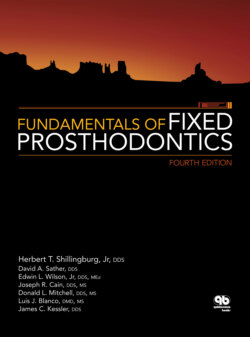Читать книгу Fundamentals of Fixed Prosthodontics - James C. Kessler - Страница 33
Occlusal interferences
ОглавлениеInterferences are undesirable occlusal contacts that may produce mandibular deviation during closure to maximal intercuspation or may hinder smooth passage to and from the intercuspal position. There are four types of occlusal interferences:
1 Centric
2 Working
3 Nonworking
4 Protrusive
The centric interference is a premature contact that occurs when the mandible closes with the condyles in their optimum position in the glenoid fossae (Fig 2-11). It will cause deflection of the mandible in a posterior, anterior, and/or lateral direction.24
A working interference may occur when there is contact between the maxillary and mandibular posterior teeth on the same side of the arches as the direction in which the mandible has moved (Fig 2-12). If that contact is heavy enough to disocclude anterior teeth, it is an interference.25
A nonworking interference is an occlusal contact between maxillary and mandibular teeth on the side of the arches opposite the direction in which the mandible has moved in a lateral excursion (Fig 2-13). The nonworking interference is particularly destructive in nature.26–29 The potential for damaging the masticatory apparatus has been attributed to changes in the mandibular leverage, the placement of forces outside the long axes of the teeth, and disruption of normal muscle function.30
Fig 2-11 A centric occlusal interference often occurs during mandibular closure between maxillary mesial-facing cusp inclines and mandibular distal-facing inclines. As a result, the mandible is deflected anteriorly.
Fig 2-12 A working interference may occur between maxillary palatal-facing cusp inclines and mandibular facial-facing cusp inclines on the working side.
Fig 2-13 A nonworking interference results when there is contact between maxillary facial-facing cusp inclines and mandibular lingualfacing cusp inclines on the nonworking side.
Fig 2-14 A protrusive interference occurs when distal-facing inclines of maxillary posterior teeth contact mesial-facing inclines of mandibular posterior teeth during a protrusive movement.
A protrusive interference is a premature contact occurring between the mesial aspects of mandibular posterior teeth and the distal aspects of maxillary posterior teeth (Fig 2-14). Because of the proximity of the teeth to the muscles and the oblique vector of the forces, contacts between opposing posterior teeth during protrusion are potentially destructive and interfere with the patient’s ability to incise properly.
Fig 2-15 (a) There may be an occlusal disharmony (shaded bar) that is not ideal but is tolerated by the patient because it is below his or her threshold of perception and discomfort. (b) If the threshold is lowered, the disharmony that had been previously tolerated may produce symptoms in the patient. (c) Treatment is then rendered by first raising the patient’s threshold and then decreasing or eliminating the disharmony.33
